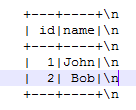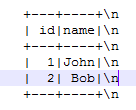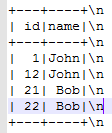Scala Example Code¶
Prerequisites¶
A datasource connection has been created on the DLI management console.
CSS Non-Security Cluster¶
Development description
Constructing dependency information and creating a Spark session
Import dependencies.
Maven dependency
<dependency> <groupId>org.apache.spark</groupId> <artifactId>spark-sql_2.11</artifactId> <version>2.3.2</version> </dependency>
Import dependency packages.
import org.apache.spark.sql.{Row, SaveMode, SparkSession} import org.apache.spark.sql.types.{IntegerType, StringType, StructField, StructType}
Create a session.
val sparkSession = SparkSession.builder().getOrCreate()
Connecting to data sources through SQL APIs
Create a table to connect to a CSS data source.
sparkSession.sql("create table css_table(id int, name string) using css options( 'es.nodes' 'to-css-1174404221-Y2bKVIqY.datasource.com:9200', 'es.nodes.wan.only'='true', 'resource' '/mytest/css')")
Table 1 Parameters for creating a table¶ Parameter
Description
es.nodes
CSS connection address. You need to create a datasource connection first.
If you have created an enhanced datasource connection, use the intranet IP address provided by CSS. The address format is IP1:PORT1,IP2:PORT2.
resource
Name of the resource for the CSS datasource connection name. You can use /index/type to specify the resource location (for easier understanding, the index may be seen as database and type as table).
Note
In Elasticsearch 6.X, a single index supports only one type, and the type name can be customized.
In Elasticsearch 7.X, a single index uses _doc as the type name and cannot be customized. To access Elasticsearch 7.X, set this parameter to index.
pushdown
Whether to enable the pushdown function of CSS. The default value is true. For tables with a large number of I/O requests, the pushdown function help reduce I/O pressure when the where condition is specified.
strict
Whether the CSS pushdown is strict. The default value is false. The exact match function can reduce more I/O requests than pushdown.
batch.size.entries
Maximum number of entries that can be inserted in a batch. The default value is 1000. If the size of a single data record is so large that the number of data records in the bulk storage reaches the upper limit of the data amount in a single batch, the system stops storing data and submits the data based on the batch.size.bytes parameter.
batch.size.bytes
Maximum amount of data in a single batch. The default value is 1 MB. If the size of a single data record is so small that the number of data records in the bulk storage reaches the upper limit of the data amount of a single batch, the system stops storing data and submits the data based on the batch.size.entries parameter.
es.nodes.wan.only
Whether to access the Elasticsearch node using only the domain name. The default value is false. If the original internal IP address provided by CSS is used as the es.nodes, you do not need to set this parameter or set it to false.
es.mapping.id
Document field name that contains the document ID in the Elasticsearch node.
Note
The document ID in the same /index/type is unique. If a field that contains a document ID has duplicate values, the document with the duplicate ID will be overwritten when the ES is inserted.
This feature can be used as a fault tolerance solution. When data is being inserted, the DLI job fails and some data has been inserted into Elasticsearch. The data is redundant. If the document ID is set, the previous data will be overwritten when the DLI job is executed again.
Note
batch.size.entries and batch.size.bytes limit the number of data records and data volume respectively.
Insert data.
sparkSession.sql("insert into css_table values(13, 'John'),(22, 'Bob')")
Query data.
val dataFrame = sparkSession.sql("select * from css_table") dataFrame.show()
Before data is inserted:

Response:

Delete the datasource connection table.
sparkSession.sql("drop table css_table")
Connecting to data sources through DataFrame APIs
Set connection parameters.
val resource = "/mytest/css" val nodes = "to-css-1174405013-Ht7O1tYf.datasource.com:9200"
Create a schema and add data to it.
val schema = StructType(Seq(StructField("id", IntegerType, false), StructField("name", StringType, false))) val rdd = sparkSession.sparkContext.parallelize(Seq(Row(12, "John"),Row(21,"Bob")))
Import data to CSS.
val dataFrame_1 = sparkSession.createDataFrame(rdd, schema) dataFrame_1.write .format("css") .option("resource", resource) .option("es.nodes", nodes) .mode(SaveMode.Append) .save()
Note
The value of SaveMode can be one of the following:
ErrorIfExis: If the data already exists, the system throws an exception.
Overwrite: If the data already exists, the original data will be overwritten.
Append: If the data already exists, the system saves the new data.
Ignore: If the data already exists, no operation is required. This is similar to the SQL statement CREATE TABLE IF NOT EXISTS.
Read data from CSS.
val dataFrameR = sparkSession.read.format("css").option("resource",resource).option("es.nodes", nodes).load() dataFrameR.show()
Before data is inserted:

Response:

Submitting a Spark job
Generate a JAR package based on the code and upload the package to DLI.
In the Spark job editor, select the corresponding dependency module and execute the Spark job.
Note
If the Spark version is 2.3.2 (will be offline soon) or 2.4.5, specify the Module to sys.datasource.css when you submit a job.
If the Spark version is 3.1.1, you do not need to select a module. Configure Spark parameters (--conf).
spark.driver.extraClassPath=/usr/share/extension/dli/spark-jar/datasource/css/*
spark.executor.extraClassPath=/usr/share/extension/dli/spark-jar/datasource/css/*
Complete example code
Maven dependency
<dependency> <groupId>org.apache.spark</groupId> <artifactId>spark-sql_2.11</artifactId> <version>2.3.2</version> </dependency>
Connecting to data sources through SQL APIs
import org.apache.spark.sql.SparkSession object Test_SQL_CSS { def main(args: Array[String]): Unit = { // Create a SparkSession session. val sparkSession = SparkSession.builder().getOrCreate() // Create a DLI data table for DLI-associated CSS sparkSession.sql("create table css_table(id long, name string) using css options( 'es.nodes' = 'to-css-1174404217-QG2SwbVV.datasource.com:9200', 'es.nodes.wan.only' = 'true', 'resource' = '/mytest/css')") //*****************************SQL model*********************************** // Insert data into the DLI data table sparkSession.sql("insert into css_table values(13, 'John'),(22, 'Bob')") // Read data from DLI data table val dataFrame = sparkSession.sql("select * from css_table") dataFrame.show() // drop table sparkSession.sql("drop table css_table") sparkSession.close() } }
Connecting to data sources through DataFrame APIs
import org.apache.spark.sql.{Row, SaveMode, SparkSession}; import org.apache.spark.sql.types.{IntegerType, StringType, StructField, StructType}; object Test_SQL_CSS { def main(args: Array[String]): Unit = { //Create a SparkSession session. val sparkSession = SparkSession.builder().getOrCreate() //*****************************DataFrame model*********************************** // Setting the /index/type of CSS val resource = "/mytest/css" // Define the cross-origin connection address of the CSS cluster val nodes = "to-css-1174405013-Ht7O1tYf.datasource.com:9200" //Setting schema val schema = StructType(Seq(StructField("id", IntegerType, false), StructField("name", StringType, false))) // Construction data val rdd = sparkSession.sparkContext.parallelize(Seq(Row(12, "John"),Row(21,"Bob"))) // Create a DataFrame from RDD and schema val dataFrame_1 = sparkSession.createDataFrame(rdd, schema) //Write data to the CSS dataFrame_1.write.format("css") .option("resource", resource) .option("es.nodes", nodes) .mode(SaveMode.Append) .save() //Read data val dataFrameR = sparkSession.read.format("css").option("resource", resource).option("es.nodes", nodes).load() dataFrameR.show() spardSession.close() } }
CSS Security Cluster¶
Development description
Constructing dependency information and creating a Spark session
Import dependencies.
Maven dependency
<dependency> <groupId>org.apache.spark</groupId> <artifactId>spark-sql_2.11</artifactId> <version>2.3.2</version> </dependency>
Import dependency packages.
import org.apache.spark.sql.{Row, SaveMode, SparkSession} import org.apache.spark.sql.types.{IntegerType, StringType, StructField, StructType}
Create a session and set the AKs and SKs.
Note
Hard-coded or plaintext AK and SK pose significant security risks. To ensure security, encrypt your AK and SK, store them in configuration files or environment variables, and decrypt them when needed.
val sparkSession = SparkSession.builder().getOrCreate() sparkSession.conf.set("fs.obs.access.key", ak) sparkSession.conf.set("fs.obs.secret.key", sk) sparkSession.conf.set("fs.obs.endpoint", enpoint) sparkSession.conf.set("fs.obs.connecton.ssl.enabled", "false")
Connecting to data sources through SQL APIs
Create a table to connect to a CSS data source.
sparkSession.sql("create table css_table(id int, name string) using css options( 'es.nodes' 'to-css-1174404221-Y2bKVIqY.datasource.com:9200', 'es.nodes.wan.only'='true', 'resource'='/mytest/css', 'es.net.ssl'='true', 'es.net.ssl.keystore.location'='obs://Bucket name/path/transport-keystore.jks', 'es.net.ssl.keystore.pass'='***', 'es.net.ssl.truststore.location'='obs://Bucket name/path/truststore.jks', 'es.net.ssl.truststore.pass'='***', 'es.net.http.auth.user'='admin', 'es.net.http.auth.pass'='***')")
Table 2 Parameters for creating a table¶ Parameter
Description
es.nodes
CSS connection address. You need to create a datasource connection first.
If you have created an enhanced datasource connection, use the intranet IP address provided by CSS. The address format is IP1:PORT1,IP2:PORT2.
resource
Name of the resource for the CSS datasource connection name. You can use /index/type to specify the resource location (for easier understanding, the index may be seen as database and type as table).
Note
In Elasticsearch 6.X, a single index supports only one type, and the type name can be customized.
In Elasticsearch 7.X, a single index uses _doc as the type name and cannot be customized. To access Elasticsearch 7.X, set this parameter to index.
pushdown
Whether to enable the pushdown function of CSS. The default value is true. For tables with a large number of I/O requests, the pushdown function help reduce I/O pressure when the where condition is specified.
strict
Whether the CSS pushdown is strict. The default value is false. The exact match function can reduce more I/O requests than pushdown.
batch.size.entries
Maximum number of entries that can be inserted in a batch. The default value is 1000. If the size of a single data record is so large that the number of data records in the bulk storage reaches the upper limit of the data amount in a single batch, the system stops storing data and submits the data based on the batch.size.bytes parameter.
batch.size.bytes
Maximum amount of data in a single batch. The default value is 1 MB. If the size of a single data record is so small that the number of data records in the bulk storage reaches the upper limit of the data amount of a single batch, the system stops storing data and submits the data based on the batch.size.entries parameter.
es.nodes.wan.only
Whether to access the Elasticsearch node using only the domain name. The default value is false. If the original internal IP address provided by CSS is used as the es.nodes, you do not need to set this parameter or set it to false.
es.mapping.id
Document field name that contains the document ID in the Elasticsearch node.
Note
The document ID in the same /index/type is unique. If a field that contains a document ID has duplicate values, the document with the duplicate ID will be overwritten when the ES is inserted.
This feature can be used as a fault tolerance solution. When data is being inserted, the DLI job fails and some data has been inserted into Elasticsearch. The data is redundant. If the document ID is set, the previous data will be overwritten when the DLI job is executed again.
es.net.ssl
Whether to connect to the security CSS cluster. The default value is false.
es.net.ssl.keystore.location
OBS bucket location of the keystore file generated by the security CSS cluster certificate.
es.net.ssl.keystore.pass
Password of the keystore file generated by the security CSS cluster certificate.
es.net.ssl.truststore.location
OBS bucket location of the truststore file generated by the security CSS cluster certificate.
es.net.ssl.truststore.pass
Password of the truststore file generated by the security CSS cluster certificate.
es.net.http.auth.user
Username of the security CSS cluster.
es.net.http.auth.pass
Password of the security CSS cluster.
Note
batch.size.entries and batch.size.bytes limit the number of data records and data volume respectively.
Insert data.
sparkSession.sql("insert into css_table values(13, 'John'),(22, 'Bob')")
Query data.
val dataFrame = sparkSession.sql("select * from css_table") dataFrame.show()
Before data is inserted:

Response:

Delete the datasource connection table.
sparkSession.sql("drop table css_table")
Connecting to data sources through DataFrame APIs
Set connection parameters.
val resource = "/mytest/css" val nodes = "to-css-1174405013-Ht7O1tYf.datasource.com:9200"
Create a schema and add data to it.
val schema = StructType(Seq(StructField("id", IntegerType, false), StructField("name", StringType, false))) val rdd = sparkSession.sparkContext.parallelize(Seq(Row(12, "John"),Row(21,"Bob")))
Import data to CSS.
val dataFrame_1 = sparkSession.createDataFrame(rdd, schema) dataFrame_1.write .format("css") .option("resource", resource) .option("es.nodes", nodes) .option("es.net.ssl", "true") .option("es.net.ssl.keystore.location", "obs://Bucket name/path/transport-keystore.jks") .option("es.net.ssl.keystore.pass", "***") .option("es.net.ssl.truststore.location", "obs://Bucket name/path/truststore.jks") .option("es.net.ssl.truststore.pass", "***") .option("es.net.http.auth.user", "admin") .option("es.net.http.auth.pass", "***") .mode(SaveMode.Append) .save()
Note
The value of Mode can be one of the following:
ErrorIfExis: If the data already exists, the system throws an exception.
Overwrite: If the data already exists, the original data will be overwritten.
Append: If the data already exists, the system saves the new data.
Ignore: If the data already exists, no operation is required. This is similar to the SQL statement CREATE TABLE IF NOT EXISTS.
Read data from CSS.
val dataFrameR = sparkSession.read.format("css") .option("resource",resource) .option("es.nodes", nodes) .option("es.net.ssl", "true") .option("es.net.ssl.keystore.location", "obs://Bucket name/path/transport-keystore.jks") .option("es.net.ssl.keystore.pass", "***") .option("es.net.ssl.truststore.location", "obs://Bucket name/path/truststore.jks") .option("es.net.ssl.truststore.pass", "***") .option("es.net.http.auth.user", "admin") .option("es.net.http.auth.pass", "***") .load() dataFrameR.show()
Before data is inserted:

Response:

Submitting a Spark job
Generate a JAR package based on the code and upload the package to DLI.
In the Spark job editor, select the corresponding dependency module and execute the Spark job.
Note
When submitting a job, you need to specify a dependency module named sys.datasource.css.
For details about how to submit a job on the DLI console, see
For details about how to submit a job through an API, see the modules parameter in
Complete example code
Maven dependency
<dependency> <groupId>org.apache.spark</groupId> <artifactId>spark-sql_2.11</artifactId> <version>2.3.2</version> </dependency>
Connecting to data sources through SQL APIs
import org.apache.spark.sql.SparkSession object csshttpstest { def main(args: Array[String]): Unit = { //Create a SparkSession session. val sparkSession = SparkSession.builder().getOrCreate() // Create a DLI data table for DLI-associated CSS sparkSession.sql("create table css_table(id long, name string) using css options('es.nodes' = '192.168.6.204:9200','es.nodes.wan.only' = 'false','resource' = '/mytest','es.net.ssl'='true','es.net.ssl.keystore.location' = 'obs://xietest1/lzq/keystore.jks','es.net.ssl.keystore.pass' = '**','es.net.ssl.truststore.location'='obs://xietest1/lzq/truststore.jks','es.net.ssl.truststore.pass'='**','es.net.http.auth.user'='admin','es.net.http.auth.pass'='**')") //*****************************SQL model*********************************** // Insert data into the DLI data table sparkSession.sql("insert into css_table values(13, 'John'),(22, 'Bob')") // Read data from DLI data table val dataFrame = sparkSession.sql("select * from css_table") dataFrame.show() // drop table sparkSession.sql("drop table css_table") sparkSession.close() } }
Connecting to data sources through DataFrame APIs
Note
Hard-coded or plaintext AK and SK pose significant security risks. To ensure security, encrypt your AK and SK, store them in configuration files or environment variables, and decrypt them when needed.
import org.apache.spark.sql.{Row, SaveMode, SparkSession}; import org.apache.spark.sql.types.{IntegerType, StringType, StructField, StructType}; object Test_SQL_CSS { def main(args: Array[String]): Unit = { //Create a SparkSession session. val sparkSession = SparkSession.builder().getOrCreate() sparkSession.conf.set("fs.obs.access.key", ak) sparkSession.conf.set("fs.obs.secret.key", sk) //*****************************DataFrame model*********************************** // Setting the /index/type of CSS val resource = "/mytest/css" // Define the cross-origin connection address of the CSS cluster val nodes = "to-css-1174405013-Ht7O1tYf.datasource.com:9200" //Setting schema val schema = StructType(Seq(StructField("id", IntegerType, false), StructField("name", StringType, false))) // Construction data val rdd = sparkSession.sparkContext.parallelize(Seq(Row(12, "John"),Row(21,"Bob"))) // Create a DataFrame from RDD and schema val dataFrame_1 = sparkSession.createDataFrame(rdd, schema) //Write data to the CSS dataFrame_1.write .format("css") .option("resource", resource) .option("es.nodes", nodes) .option("es.net.ssl", "true") .option("es.net.ssl.keystore.location", "obs://Bucket name/path/transport-keystore.jks") .option("es.net.ssl.keystore.pass", "***") .option("es.net.ssl.truststore.location", "obs://Bucket name/path/truststore.jks") .option("es.net.ssl.truststore.pass", "***") .option("es.net.http.auth.user", "admin") .option("es.net.http.auth.pass", "***") .mode(SaveMode.Append) .save(); //Read data val dataFrameR = sparkSession.read.format("css") .option("resource", resource) .option("es.nodes", nodes) .option("es.net.ssl", "true") .option("es.net.ssl.keystore.location", "obs://Bucket name/path/transport-keystore.jks") .option("es.net.ssl.keystore.pass", "***") .option("es.net.ssl.truststore.location", "obs://Bucket name/path/truststore.jks") .option("es.net.ssl.truststore.pass", "***") .option("es.net.http.auth.user", "admin") .option("es.net.http.auth.pass", "***") .load() dataFrameR.show() spardSession.close() } }